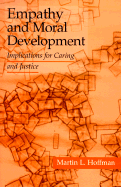Book contents
- Frontmatter
- Contents
- Acknowledgments
- 1 Introduction and Overview
- Part I Innocent Bystander
- 2 Empathy, Its Arousal, and Prosocial Functioning
- 3 Development of Empathic Distress
- 4 Empathic Anger, Sympathy, Guilt, Feeling of Injustice
- Part II Transgression
- Part III Virtual Transgression
- Part IV Is Empathy Enough?
- Part V Empathy and Moral Principles
- Part VI Culture
- Part VII Intervention
- References
- Author Index
- Subject Index
2 - Empathy, Its Arousal, and Prosocial Functioning
Published online by Cambridge University Press: 05 June 2012
- Frontmatter
- Contents
- Acknowledgments
- 1 Introduction and Overview
- Part I Innocent Bystander
- 2 Empathy, Its Arousal, and Prosocial Functioning
- 3 Development of Empathic Distress
- 4 Empathic Anger, Sympathy, Guilt, Feeling of Injustice
- Part II Transgression
- Part III Virtual Transgression
- Part IV Is Empathy Enough?
- Part V Empathy and Moral Principles
- Part VI Culture
- Part VII Intervention
- References
- Author Index
- Subject Index
Summary
People are innocent bystanders when they witness someone in pain, danger, or any other form of distress. The distress can involve physical pain or discomfort due to injury or disease, emotional pain over the loss or expected loss of a loved one, fear of being attacked, anxiety over failure or financial impoverishment, and the like. The moral issue in these situations is whether the bystander is motivated to help and if he is, the extent to which the motivation is self-serving or based on true concern for the victim. The bystander model is the prototypic moral encounter for empathic distress and related empathic affects. It is also the context for my theory of empathy development. In this chapter I give my definition of empathy, provide evidence that it functions as a prosocial motive, and then describe the mechanism by which it is aroused. In chapters 3 and 4,1 present the theory of empathy development and discuss four empathy-based feelings that also function as prosocial motives: sympathetic distress, empathy-based anger, empathy-based feeling of injustice, and guilt over inaction. In subsequent chapters I deal with other types of moral encounters.
DEFINITION OF EMPATHY
Empathy has been defined by psychologists in two ways: (a) empathy is the cognitive awareness of another person's internal states, that is, his thoughts, feelings, perceptions, and intentions (see Ickes, 1997, for recent research); (b) empathy is the vicarious affective response to another person.
- Type
- Chapter
- Information
- Empathy and Moral DevelopmentImplications for Caring and Justice, pp. 29 - 62Publisher: Cambridge University PressPrint publication year: 2000
- 3
- Cited by



